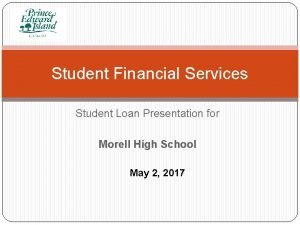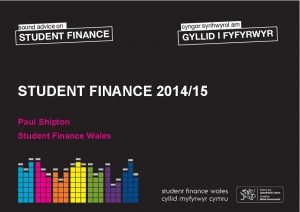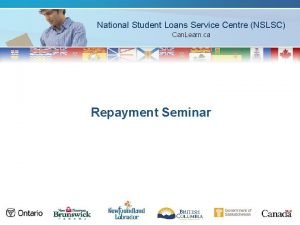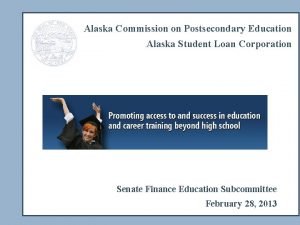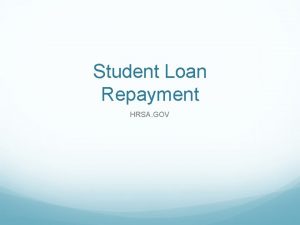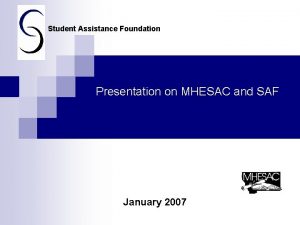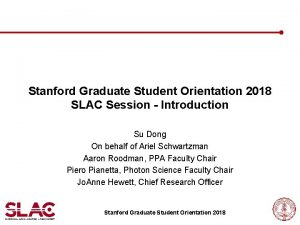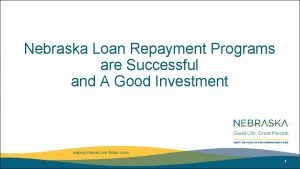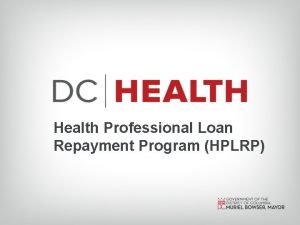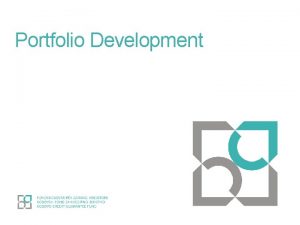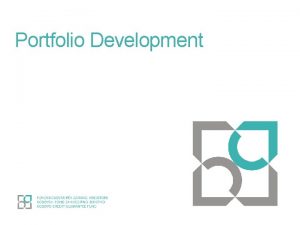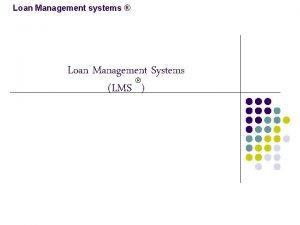Does Student Loan Amount affect Choice of Program












- Slides: 12

Does Student Loan Amount affect Choice of Program of Study? Evidence from Privately Sponsored Undergraduate HELB Loan Recipients in Public Universities in Western Kenya By Ogenga, Paul Akumu (Ph. D) POSTGRADUATE SEMINAR SERIES No. 2 FOR 2018 (DPGS Melting Pot)

Introduction q. When free to do so, people choose occupations that offer them the highest returns on their abilities q. However, studies show that participation in higher education in Sub-Saharan Africa is selective and markedly differentiated in terms of socio-economic classes q. In Kenya specific, higher education inequality is overwhelmingly high 2

Cont. . . q. Besides, enrolment in competitive programmes in STEM is skewed in favour of students from privileged backgrounds q. Public universities allowed to mount PSSPs to widen participation q. However, cost of PSSP vary with discipline & way costly for the majority poor q. Against this backdrop, govn’t expanded the scope of HELB to cover PSSP students from 2008 3

Purpose of the Study q. This study sought to establish the effect of higher education loan amount on choice of program of by privately sponsored undergraduate students in public universities in Western Kenya 4

Methodology; Sample q. Sampling done at respondent and institutional levels q. Mathematical formula (Watson, 2001) and multistage technique used to get sample size q. Sample of 517 proportionately drawn from the 2012/2013 cohort of privately sponsored HELB loan recipients in three public universities in western Kenya q. . Research Output. Sample Size Table. doc q. Simple random sampling method was thereafter used to select individual student respondent 5

Methodology; Analysis q. Multiple logistic regression analysis was used to model the r/ship btw HELB loan amount & type of program of study while controlling for student level characteristics & university factor q. Used to predict probabilities of possible outcomes of >2 level categorically distributed DV, given a set of IV which may be real valued, binary or categorical -valued q. Justification: Enabled sequential modelling when DV (program of study) is 3 level categorical variable 6

Cont. . . q Prior to modelling, pair wise correlation & chisquare with Cramer’s V were used to correlate the outcome variable with possible continuous & categorical explanatory variables respectively q Only variables which had significant r/ship with DV were pursued further in the regression analysis q Loan amount & KCSE performance were the only sig. Continuous variables q Sex, socio-econ status, educ. att of hh head and university were the only sig. categorical variables q As such 3 sequential models were developed 7

Results q Descriptive statistics of the IV (Loan Amount) Mean (40207. 69), Mode (35000) Median (37000) q Research output. Findings. doc q Loan amount was stat. significant in both scenarios in the 1 st model q It however became stat. insignificant in both scenarios when student-level characteristics were controlled for in the 2 nd model. q Furthermore, while controlling for both student level characteristics and university of enrolment in the 3 rdmodel, the loan amount was still statistically insignificant 8

Cont. . . q. This could be attributed to the inadequate amounts of loan awarded to the individual student relative to the cost of such programmes of study q. However, some student level xtics and university factor were stat. sig in some scenarios q. They include source of financing, KCSE performance, family socio-economic status and highest educational attainment of head of household 9

Summary of findings q. This study did not find any significant relationship between HELB loan amount and type of programme of study by privately sponsored undergraduate students in public universities in western Kenya. q. Instead, the loan amount was found to be inadequate relative to tuition fees charged at the universities for PSSPs. (covering only 36. 56% for the least cost program) 10

Conclusions q. Higher education loan amount doesn't affect choice of program of study among PSSP students in public universities western Kenya. q. In spite of loan, some student level characteristics continue to affect choice of program of study 11

Recommendations q. Higher education loan award criteria should be reviewed to factor in the cost of tuition for each privately sponsored program of study. q. This will enable students to freely enrol into programme of choice, cost notwithstanding. 12
 This veterans basic entitlement is $36 000*
This veterans basic entitlement is $36 000* Va regional loan center roanoke
Va regional loan center roanoke Mypath student loan
Mypath student loan Student loan wales
Student loan wales Nslsc ontario
Nslsc ontario Alaska advantage student loan
Alaska advantage student loan Hrsa student loan forgiveness
Hrsa student loan forgiveness Montana higher education student assistance corporation
Montana higher education student assistance corporation Slac student loan
Slac student loan Good choice or bad choice
Good choice or bad choice Section 502 guaranteed rural housing loan program
Section 502 guaranteed rural housing loan program Nebraska loan repayment program
Nebraska loan repayment program Dc health professional loan repayment program
Dc health professional loan repayment program


